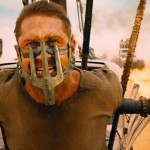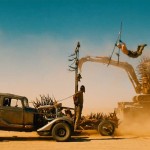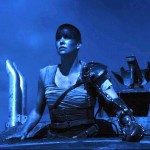Mad For Max
Mad Max: Fury Road is hands down my favourite film so far this year, and it's set a high bar to get over for the remaining six months. I have a somewhat odd record with the previous 3 films — the original film didn't interest me all that much — it lacks the gonzo post-apocalypse elements of the later ones, and violent action on its own, however well presented, doesn't push my buttons that much. Road Warrior I enjoyed far more, which sets the tone and the aesthetic for the series, but my guilty secret is that Thunderdome — the one most people say is the worst — has always been my favourite. Yes, it has less cars and less action, but at the same time I really like the whole Thunderdome society, and the community of children at the plane crash is marvellously realised — a really nice piece of SF in a way that Chris Beckett would follow on with his award-winner Dark Eden (not that Beckett's necessarily riffing on MM3, but the idea of a mythology arising out of children's half-understandings is clear in both).
Fury Road is the best yet, taking what worked from the previous movies and adding in a whole extra nitro-injection of additional thought and insanity. In my humble opinion, here's what's so great, about the film and the franchise as a whole. Spoilers below, I'm sure, but I really, really, encourage you to go watch the film anyway, if you haven't already.
From Road Warrior this has been a real strength of the franchise. It may seem a weird thing to single out about a series of films that are basically a lot of cars on fire covered in spikes being riddled with bullets. Mad Max films almost never stop to explain anything (save maybe in Thunderdome), and the world presented to the viewer is madder than Max is: Humungus's motorised army, the pig-powered Thunderdome, the warlords of Fury Road, it all just explodes onto the screen and then doesn't stop running, demanding that we keep up, It's all spikes and deformities and insane customs, cruelty and mad, mad ways of life that couldn't possibly last another generation. But that's the point: it's the end of the world. We're being shown the last diseased flowers of human society now the oil, the water, the everything has run out. Most films offer a thin thread of hope for the future, but on all sides it's threatened by the madness of human nature backed into a corner. And there's a hell of a lot of detail making up the craziness. George Miller doesn't need to stop and tell us what's going on because the people we see, their broken culture and their ways, it all convinces the moment it hits the eye — there's always enough context that any 'Why is…?; questions are answered. Personal favourite tiny detail: that bridle Max is wearing while he's strapped to the front of the car — have a look at it. That's mostly made from the head of a garden fork; you can even see the hole where it would have been attached to the handle.
2. Characters
Another great strength of the MM films has been creating enormously idiosyncratic characters with just a few quick brush strokes — not only big roles like the gyro captain/aviator (Bruce Spence's magnificent defining role), Aunty from Thunderdome; the valiant Angharad or the hapless Warboy Nux from Fury Road, but everyone, every role is full of personality and character — you have an immediate sense of how they fit into Max's mad world without anyone needing to talk the viewer through it. With both character and world, Miller and the various teams he has worked with are really giving a masterclass on how to bring their films alive, layering detail on detail to create briefly glimpsed vistas that convince the viewer of a wider setting, and a wider history that brought everything to that state.
3. Max is mad
Just a small note for Fury Road but, yeah, Max is far more pointedly mad this time, suffering from serious PTSD because of all the terrible things he's seen, and because of the people he couldn't save. He starts off little more than an animal: almost wordless save for demands about the trappings taken away from him, fixated solely on his own survival. Furiosa's quest gives him a reason to come back to his humanity, but he's a genuinely traumatised person who has great difficulty relating to other human beings.
Probably a very personal point but — well, I listen to a lot of music written for film trailers. For writing action scenes, it's second to none — most pieces are basically two minutes of 100% adrenaline. That's not to say the MM4 soundtrack is just that, but there are some cracking tracks on it. I also really enjoyed the way the composer, Tom Holkenborg, meshed the incidental music with the drumming/electric guitar from Immortan Joe's musicwagon so seamlessly. So, yes, no serious critical point here except that I went out and bought the soundtrack as soon as I got home after watching the film.
5. Action
Apparently around 80% of the effects shots in Fury Road (and all of the shots in the previous films for obvious reasons) were physical effects — actual cars, actual explosions, actual stunts, and it shows. Those scenes that do rely heavily on CGI come over as a bit ropy in comparison, but it is incredibly refreshing to get that much reality in a film like this. Cracked.com has an article here that talks about why CGI often fails to convince, and if you have a film with a visual aesthetic as outright lunatic as Mad Max, grounding it with physical effects is a good move. More than that, Miller is an artist of the chase scene and the action shot — there's no cheating, none of the quick cuts, the inconsistent positioning — everything is there, everything keeps continuity. People do absurdly dangerous things, and that danger is actively sold to us, rather than brushed under the carpet.
6. Charlize Theron
Tom Hardy makes a good Max. Theron gives us the sort of female action lead we haven't really seen since Ellen Ripley. Imperator Furiosa is a fully-rounded action hero who does everything an action hero needs to do. She drives the plot, and the main character arc is hers, for all her story allows Max to find something to fight for. Like Ripley, what Furiosa does doesn't overtly demand a female character — she's not female so she can fall in love with Max, for example — and like Ripley the film cuts her no slack whatsoever, beats on her unmercifully and does its level best to kill her at every opportunity. Theron is splendid, both on her own and working with Hardy and the rest of the cast.
Not an actual elephant — it's just about the only piece of spectacle the film doesn't have. The elephant in the exploding spiky room, however. You've probably heard that there's been some controversy about Mad Max not being a "Man's film" and conning men by concealing feminist rhetoric under its explosions. Or something. Is there anything to this? Well… look: the plot is about the rescue of a warlord's wives (his 'property' as he shouts) by a female road warrior; there are a large number of female characters who are treated with the same brutally demanding hand by their world and by the action as the male. Is this some attack on masculinity? No. The film is very happy to let any character step up to the hero plate — the wives, the Many Mothers, Max or even Nicholas Hoult's intensely likeable Nux. Nux, of course, is as much a victim of the Warboy society as everyone else — a living illustration of Laurie Penny's point in her Unspeakable Things that a patriarchal society doesn't run itself for the benefit of men, but for that of patriarchs like Joe. Fury Road is a glorious, fast-moving, explosive example of why diversity improves a film.
All pictures taken from IO9 — mostly their superb review here — as I assume these are publicity shots for general free use. Please let me know if not via Twitter @aptshadow.



 © 2008-2025 Pan Macmillan
© 2008-2025 Pan Macmillan
Couldn't agree more. This movie restored my faith in film-making, and I'm boggled he was allowed to make it.